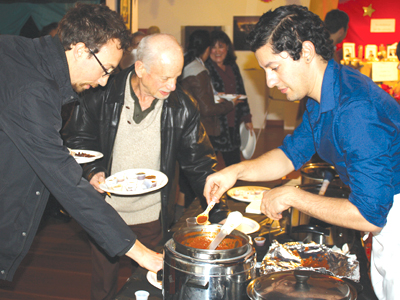
Moises Chavez spent three days preparing his mole negro for a recent mole competition event in San Francisco. On November 19th, the Mission Cultural Center for Latino Arts hosted its 10th annual Mole To Die For competition, a community-judged mole contest open to local chefs and home cooks. Mole loving cooks competed while mole lovers tasted and judged which mole was best.
Competitors prepared red, green, yellow, and black moles. While dark and chocolate moles tend to get starring roles on most American menus, the slow-cooked sauce has much more of a range.
Chavez, 49, from Oakland, won first place in the competition. Originally from Huajuapan de Leon, Oaxaca, Chavez has been cooking mole for more than ten years and says that in his home town every family has their own mole recipe and many of those recipes go back for many generations.
Chavez won the contest with his ‘mole negro’, made from a friend’s recipe that has been used for more than 60 years.
“This kind of mole is delicious but complicated to make it,” said Chavez. “The mole negro is called the king of the moles.”
It took Chavez three days to prepare his mole. “[The mole] is a laborious work; you have to cook in different stages,” said Chavez. “I love to cook, and to cook mole is very spiritual, you have to enjoy the process, because is a lot of work.”
The recipe to make mole negro is complicated, containing three different chili peppers, ancho, pasilla y negro; and more than twenty other different ingredients, like chocolate, plantain, raisins, cashews, walnuts, among others.
“When cooking mole, everything has to have the right balance, the amount, the roast, the frying, and the cooking time,” says Chavez. “Not everybody can cook this mole. My inspiration is to promote the artisanal mole and continue with the Oaxacan tradition of making mole.”
“It was a great event,” said Andreina Maldonado, events and media coordinator at Mission Cultural Center for Latino Arts in San Francisco.
“There were thirteen different kinds of mole, representing different states of Mexico. It was a cultural education - we learned about culture and traditions through food.”
Maldonado added that the event attendees represented a very multicultural mix. “It was very good – it symbolizes the union and understanding among cultures.”
Monica Beristain, 41, won third place at the competition. Originally from Mexico City, Beristain has a food engineering degree and wants to start a business next year.
“I love to cook and I want to commercialize my mole,” she said. “I decided to enter the contest because I wanted to study the market for my mole - I did not expect to win.”
Beristain presented a mole rojo, known as mole poblano.
“The recipe is from my mom, she taught me how to cook it. This mole has chocolate and more than twenty different ingredients, like sesame seeds, garlic, onion, cloves. The process it is very particular because the chili peppers have to be roasted to perfection to give the flavor that we want.”
The history of the mole goes back to the pre-Columbian era and there are several versions of its origin. It is said that the Aztecs prepared for the great lords a complex dish called "mulli," meaning porridge or mixture. Another story places the mole poblano in the Convent of Santa Rosa in Puebla (Mexico) when a nun grounded together various chilies and other seasonings in a metate. Another version says that Spaniards brought different condiments to the natives, who then used them to transform the fusion of the mole. There are many histories of the mole, but it is clear that it is one of the greatest gifts that indigenous people have contributed to the world.
